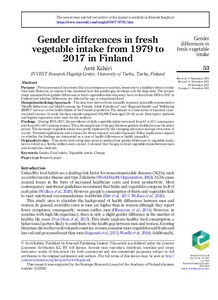Gender differences in fresh vegetable intake from 1979 to 2017 in Finland
Kähäri Antti
https://urn.fi/URN:NBN:fi-fe2022012710829
Tiivistelmä
Purpose
Previous research has shown that in contemporary societies, women have a healthier dietary intake than men. However, no research has examined how this gender gap develops over the long term. The present study examined how gender differences in fresh vegetable intake frequency have evolved from 1979 to 2017 in Finland and whether differences are affected by age or educational level.
Design/methodology/approach
The data were derived from annually repeated, nationally representative “Health Behaviour and Health among the Finnish Adult Population” and “Regional Health and Well-being (RHW)” surveys on the health habits of the Finnish population. The dataset is a time series of repeated cross-sectional surveys. In total, the data sample comprised 161,996 Finns aged 20–64 years. Descriptive methods and logistic regression were used for the analysis.
Findings
During 1979–2017, the prevalence of daily vegetable intake increased from 12 to 35% among men and from 18 to 56% among women. Thus, the magnitude of the gap between genders doubled across the study period. The increased vegetable intake was partly explained by the changing education and age structures of society. Potential explanations and avenues for future research are also discussed. Policy implications depend on whether the findings are interpreted as a case of health differences or health inequality.
Originality/value
This study used a long time series to analyse how gender differences in vegetable intake have evolved in a Nordic welfare state context. It showed that the gap in fresh vegetable intake between men and women has widened.
Kokoelmat
- Rinnakkaistallenteet [27094]
